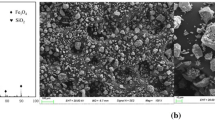Abstract
Compared with natural magnetite concentrate, artificial magnetite with more lattice defects and higher activity tends to be oxidized. And the artificial magnetite pellet at the temperature of 400 °C has the oxidation degree approaching to natural magnetite concentrate pellet fired at 1000 °C. Besides, two kinds of pellets displayed quite different roasting characteristics. When preheated at the same temperature for the same period of time, natural magnetite concentrate pellet and artificial magnetite concentrate pellet need to be roasted at the temperature of 1100 °C and 1250 °C, respectively, for 25 min to reach the compressive strength of 3000 N per pellet. When roasted at the same temperature of 1200 °C, natural magnetite pellet and artificial magnetite pellet need to be roasted for 15 min and 30 min, respectively, to reach the compressive strength over 3000 N per pellet. It can be seen from the test that artificial magnetite pellet has a faster oxidation, resulting in the high porosity in the produced pellet, and it requires a roasting process at higher temperature for a longer time to reach the desired compressive strength for industrial production.
Similar content being viewed by others
References
CHO H J, TANG M, PISTORIUS P C. Magnetite particle size distribution and pellet oxidation [J]. Metallurgical and Materials Transactions B, 2014, 45B: 1213–1220.
PANG Jian-ming, GUO Pei-min, ZHAO Pei. Reduction of 1-3 mm iron ore by CO on fluidized bed [J]. Journal of Iron and Steel Research, International, 2011, 18(3): 1–5.
PANGEY B K, SHARMA T. Reducing agents and double-layered iron ore pellets [J]. International Journal of Mineral Processing, 2000, 59: 295–304.
JIANG Chang-wei, FU Ju-ying, LI Si-dao, YAO Jun-feng. Study on the Induration property of Aoshan magnetite concentrates pellets [J]. Journal of Central South University of Technology: Natural Science, 1998, 29(5): 435–437. (in Chinese)
FU Ju-ying, LI Yun-tao, JIANG Chang-wei, WANG Li-guang. Oxidation kinetics of magnetite concentrate pellets [J]. Journal of Central South University: Natural Science, 2004, 35(6): 950–954. (in Chinese)
FORSMO S P E, SAMSKOG P O, BJORKMAN B M T. A study on plasticity and compression strength in wet iron green pellets related to real process variations in raw material fineness [J]. Powder Technology, 2008, 181: 321–330.
LIU Shu, LU Man-man, FU Jin-tao, ZOU Peng, ZHANG Han-quan. Influences of content of iron materials with partical size of -0.025 mm on ballability of magnetite concentrates [J]. Sintering and Pelletizing, 2014, 39(5): 31–34.
ZHANG Han-quan, WANG Feng-ling. Regulation of mineral composition and phase transformation in limonite magnetic roasting process [J]. Journal of Iron and Steel Research, 2014, 26(7): 8–11. (in Chinese)
FU Ju-ying, JIANG Tao, ZHU De-qing. Principle of sintering and pelletizing [M]. Changsha: Central South University of Technology Press, 1996. (in Chinese)
ZHANG Han-quan, WANG Feng-ling. Analysis of surface wettability of synthetic magnetite [J]. Journal of Wuhan University of Technology: Mater, 2014, 29(4): 679–683.
FORSMOA S P E, FORSMOA S E, SAMSKOG P O, BJÖRKMAN B M T. Mechanisms in oxidation and sintering of magnetite iron ore green pellets [J]. Powder Technology, 2008, 183: 247–259.
HUANG Xiao-yan, GUO Shan-shan, LI Huai-hua, et al. Research on magnetic properties and magnetic separation behavior of natural and artificial magnetite [J]. Mining and Metallurgical Engineering, 2012, 32(2): 30–33. (in Chinese)
ESTHER L, JAVIER H, JOSE A P. Steam-iron process: Influence of steam on the kinetics of iron oxide reduction [J]. International Journal of Hydrogen Energy, 2011, 36: 13425–13434.
FAN Jian-jun, QIU Guan-zhou, JIANG Tao, SHEN Hui-ting. Roasting properties of pellets with iron concentrate of complex mineral composition [J]. Journal of Iron and Steel Research International. 2011, 18(7): 1–7.
BUIYAN L U, MOUZON J, FORSMO S P E, HEDLUND J. Quantitative image analysis of bubble cavities in iron ore green pellets [J]. Powder Technology, 2011(214): 306–312.
BAI Guo-hua, ZHOU Xiao-qing. Study on pelletizing of pyrite cinder with magnetite [J]. Iron and Steel, 2009, 44(7): 7–10. (in Chinese)
Author information
Authors and Affiliations
Corresponding author
Additional information
Foundation item: Project(51474161) supported by the National Natural Science Foundation of China
Rights and permissions
About this article
Cite this article
Zhang, Hq., Lu, Mm. & Fu, Jt. Oxidation and roasting characteristics of artificial magnetite pellets. J. Cent. South Univ. 23, 2999–3005 (2016). https://doi.org/10.1007/s11771-016-3363-y
Received:
Accepted:
Published:
Issue Date:
DOI: https://doi.org/10.1007/s11771-016-3363-y




